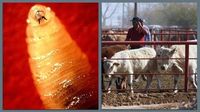For the first time in decades, a rare flesh-eating parasite known as the New World screwworm has been detected in a human in the United States, stirring memories of a threat once thought eradicated from American soil. The patient, a Maryland resident who had recently traveled to El Salvador, was diagnosed with the parasite on August 4, 2025, according to statements from the Centers for Disease Control and Prevention (CDC) and the Maryland Department of Health. The case has been confirmed as the first travel-associated human infection from an outbreak-affected country identified in the U.S., federal health officials said.
The infected individual has since recovered, and both health officials and investigators have found no evidence of transmission to other people or animals. "There is no indication of transmission to any other individuals or animals," a spokesperson for the Maryland Department of Health stated, as reported by CNN. The CDC, working alongside the Maryland Department of Health, swiftly investigated the case, employing telediagnosis—expert review of submitted images of the larvae—to confirm the infection, according to Axios.
But what exactly is the New World screwworm, and why is its reappearance causing such concern? The parasite, whose Latin name Cochliomyia hominivorax translates roughly as "man eater," is a metallic blue blowfly species. Unlike other blow flies native to the Western Hemisphere, the New World screwworm lays its eggs in open wounds or body openings of warm-blooded animals—including humans. Once hatched, the larvae burrow into living flesh, feeding on tissue and causing wounds that can quickly become severe. "After mating, the female fly finds a living host, lands on its wound, and will lay up to 200 to 300 eggs," explained Dr. Phillip Kaufman, an entomologist at Texas A&M University, in remarks to CNN. "After 12 to 24 hours, those eggs all hatch, and they immediately start burrowing and feeding on the tissue of that animal, causing very, very large wounds to form."
While the parasite is rare in humans, it poses a significant threat to livestock, pets, and wildlife. Symptoms in humans include painful, unexplained wounds or sores that do not heal, the presence of maggots around open sores, and a foul-smelling odor from the affected area. Treatment typically involves the removal of larvae, sometimes requiring surgical intervention. The CDC strongly advises against attempting to remove the maggots without medical supervision.
The New World screwworm is typically found in South America and the Caribbean, but recent years have seen its spread northward through Central America and into southern Mexico. Outbreaks have been recorded since early 2023 in Belize, Costa Rica, El Salvador, Guatemala, Honduras, Mexico, Nicaragua, and Panama, according to CNN. The fly reached southern Mexico late last year, sparking heightened concern among U.S. agricultural officials and prompting the closure of several border-area livestock trading ports in 2025.
For ranchers and the agricultural industry, the stakes are high. The U.S. Department of Agriculture (USDA) estimates that if a screwworm outbreak were to impact Texas, the nation’s largest cattle-producing state, the economic damage could reach $1.8 billion, Axios reported. More broadly, the USDA has warned that a widespread outbreak could threaten more than $100 billion in economic activity tied to the cattle and livestock industry, as reported by BBC and Bloomberg.
The pest’s history in the U.S. is a story of both devastation and triumph. Screwworm was a recurring problem for ranchers in Florida and Texas for decades, until an ambitious eradication campaign in the 1960s and 1970s. Scientists used a novel biological control technique: breeding billions of sterile male flies and releasing them by air over affected regions. The sterile males would mate with wild females, but produce no offspring, gradually collapsing the population. This campaign was so successful that the U.S. declared victory over the parasite, and the infection faded from public memory. The USDA also eliminated a small outbreak in the Florida Keys as recently as 2017, according to Axios.
However, the resurgence of screwworm in Central America and Mexico has reignited concerns that the parasite could return to the U.S. “If it does, the Texas-Mexico border area is likely to be the first place to see it,” said Max Scott, a North Carolina State University researcher who has studied the parasite, as quoted by the Associated Press. In response, the USDA has ramped up efforts to bolster the country’s defenses. This month, the agency announced the construction of a fly production facility in Edinburg, Texas, at Moore Air Force Base, with the capacity to produce up to 300 million sterile flies per week. The USDA will work in concert with similar facilities in Panama and Mexico, and has also committed up to $100 million for technologies such as traps, lures, therapeutics, and advanced surveillance techniques—including the training of screwworm detection dogs and the deployment of mounted patrol officers known as "Tick Riders."
“The construction of a domestic sterile fly production facility will ensure the United States continues to lead the way in combating this devastating pest,” USDA Secretary Brooke Rollins said this month, as reported by CNN. “If our ranchers are overrun by foreign pests, then we cannot feed ourselves.”
Meanwhile, the federal government is taking additional measures to protect both animal and public health. The U.S. Department of Health and Human Services recently issued an emergency declaration, allowing the Food and Drug Administration greater flexibility to authorize animal drugs for treating and preventing New World screwworm infestations, since no FDA-approved drugs currently exist for this purpose in the United States.
Despite the alarming nature of the parasite, officials stress that the risk to the general public remains very low. “Currently, the risk to public health in the United States from this introduction is very low,” HHS spokesperson Andrew Nixon emphasized in an email to CNN. National Cattlemen’s Beef Association CEO Colin Woodall praised the swift and coordinated response between federal and state agencies, stating, “This case was quickly addressed thanks to existing protocols, and we are thankful for the ongoing coordination between the CDC, state departments of health, state animal health officials, and USDA.”
For now, the Maryland case stands as a stark reminder of the importance of vigilance, routine monitoring, and international cooperation. As outbreaks continue to move north through the Americas, the U.S. faces a renewed challenge to keep the screwworm—and the economic and ecological devastation it brings—at bay.





